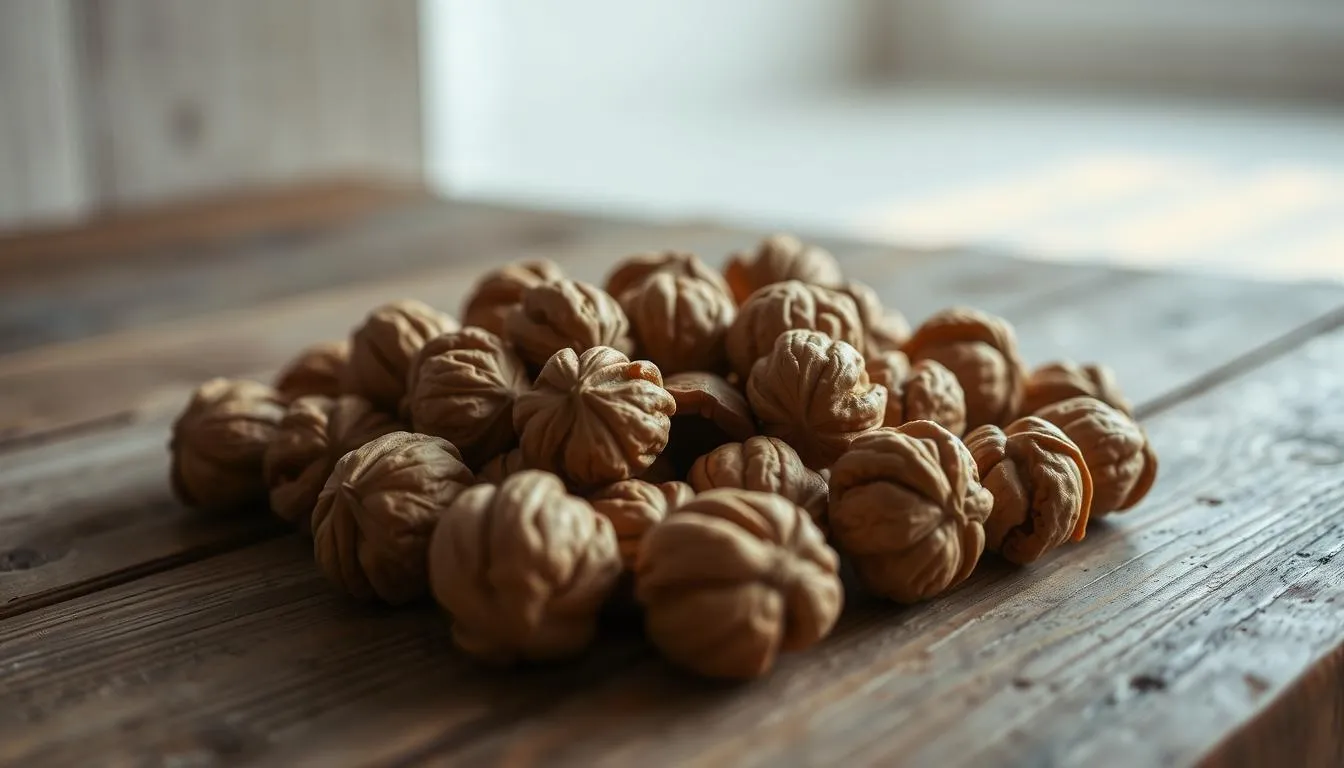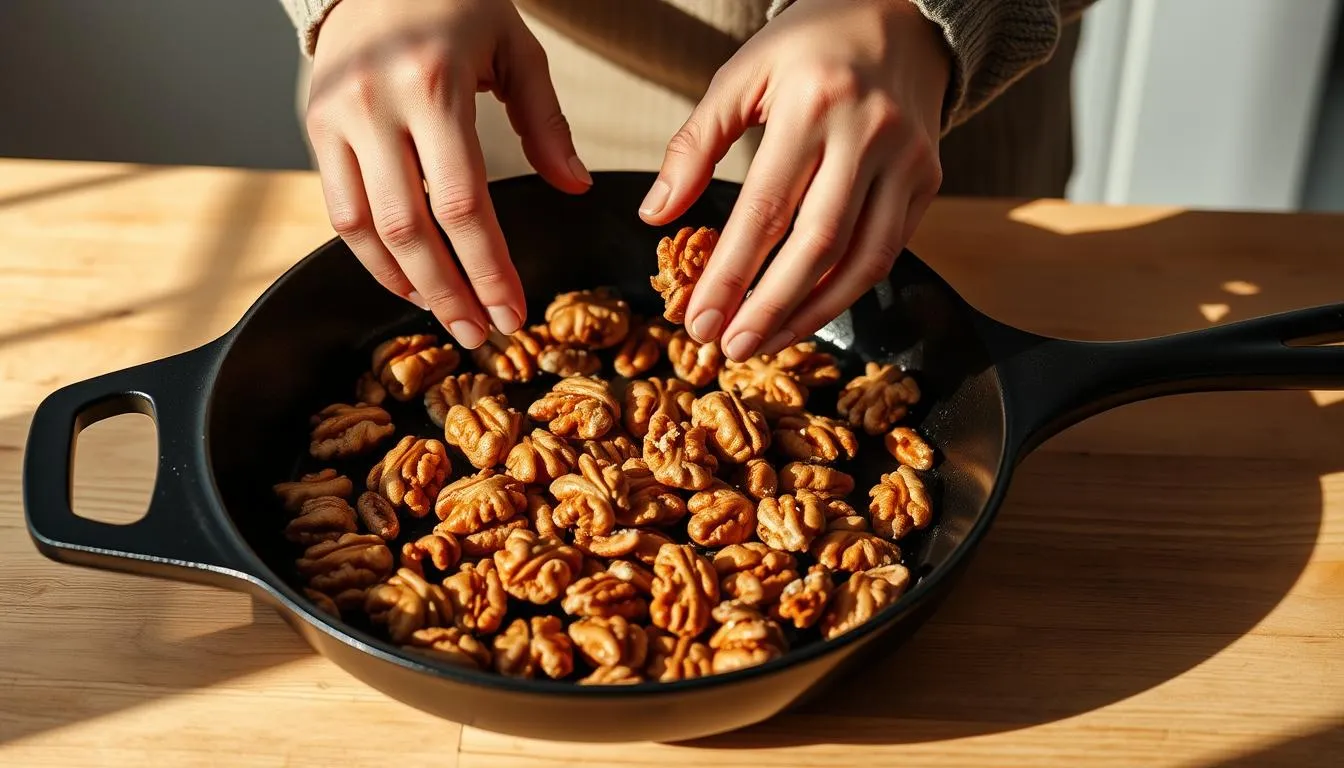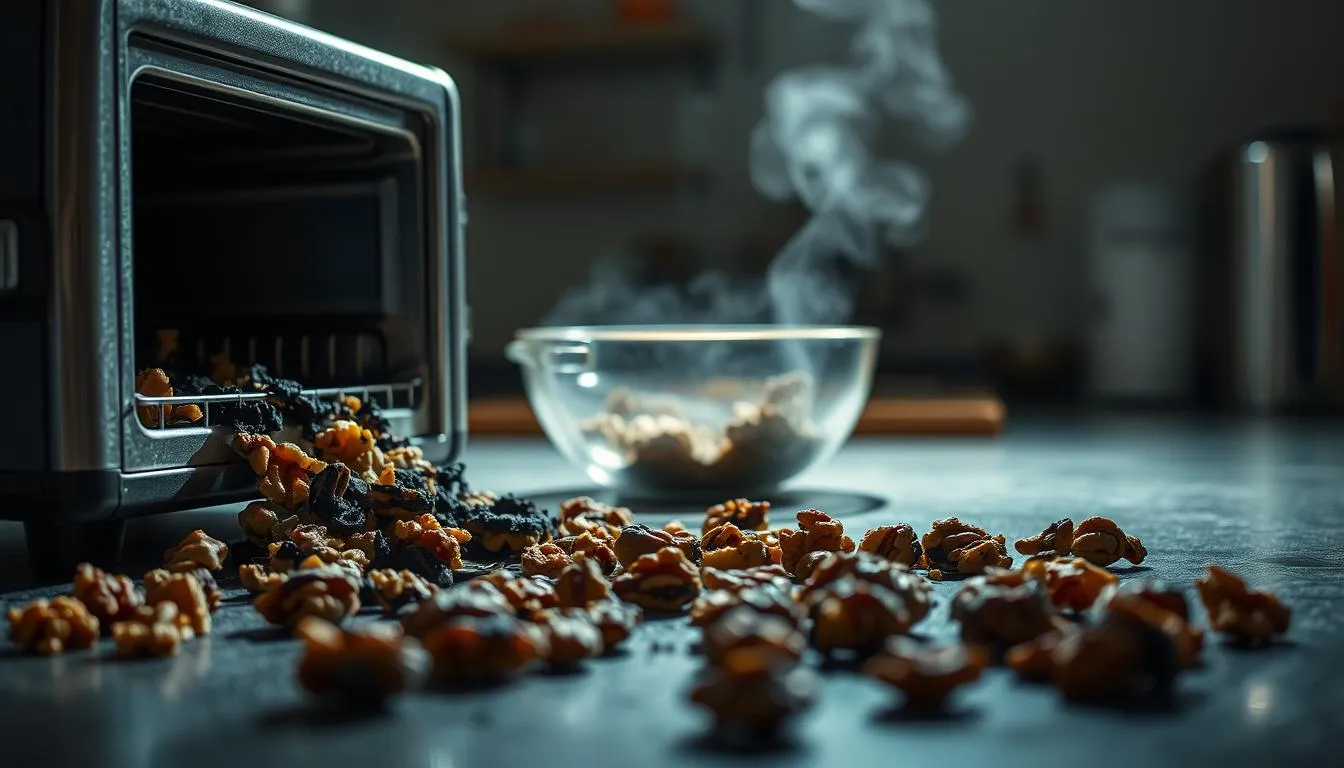When baking cookies, using each ingredient well is key for great taste and texture. Many bakers wonder if toasting walnuts before adding them to dough is worth it. Toasting walnuts can improve your cookies’ flavor and texture. But do you really need to do it? Let’s dive into the benefits and how to toast walnuts before baking.
Adding toasted walnuts to cookies can bring a deep, nutty taste that pairs well with their sweetness. Toasting walnuts might seem like an extra step, but it can greatly enhance your cookies. Whether you’re an experienced baker or just starting, learning about toasting walnuts can elevate your cookie game.
Key Takeaways
- Toasting walnuts can enhance the flavor and texture of your cookies
- Baking cookies with toasted walnuts can add a rich, nutty flavor
- Toasting walnuts is a simple process that can make a significant difference in the final product
- Understanding the benefits of toasting walnuts can help you improve your cookie-baking skills
- Toasting walnuts before baking cookies can be a key step for the best flavor and texture
- Toasting walnuts is a step worth considering when baking cookies with walnuts
The Science Behind Toasting Walnuts
Toasting walnuts triggers complex chemical changes. These changes make the nuts taste better and feel different. The Maillard reaction, a heat process, breaks down amino acids and sugars. This transforms the nut oils and flavors into something richer.
Toasting affects the nut oils a lot. Heat breaks them down into new compounds. This makes the walnuts taste more intense and nutty. The texture also changes, becoming crunchier and more enjoyable.
Chemical Changes During Toasting
The changes during toasting depend on temperature, time, and walnut type. The best temperature is between 350°F and 400°F. This temperature range is key for the right balance of flavor and texture.
Impact on Nut Oils and Flavors
Toasting also enhances the walnuts’ flavor. Heat creates new compounds like aldehydes and ketones. These molecules add to the nuts’ aroma and taste.
Temperature Effects on Texture
The toasting temperature greatly affects the nuts’ texture. Too high, and they become brittle. Too low, and they stay chewy. Knowing the science behind toasting helps you get the perfect texture and flavor.
| Temperature | Time | Texture |
|---|---|---|
| 350°F | 10-12 minutes | Crunchy |
| 400°F | 8-10 minutes | Brittle |
| 300°F | 15-18 minutes | Chewy |
Benefits of Using Toasted Walnuts in Cookies
Toasting walnuts before baking can greatly enhance the flavor of your cookies. This method releases the natural oils in walnuts, making them more flavorful and aromatic. Think about using toasted walnuts in recipes like walnut cookies or cakes for a deeper taste.
Some benefits of toasting walnuts include:
- Improved texture: Toasting walnuts can make your cookies crunchier and more enjoyable to eat.
- Enhanced flavor: The toasting process brings out the walnuts’ natural flavors, adding to your cookies’ taste.
- Increased aroma: Toasted walnuts give your cookies a rich, nutty scent, making them more appealing.
To get the best flavor and texture, toast walnuts until they’re lightly browned and fragrant. Then, chop them up and add them to your favorite cookie recipes. Enjoy the flavor enhancement and texture improvement they bring.
With these benefits in mind, try a new recipe with toasted walnuts as the main ingredient. You might be amazed at how it changes your cookies’ taste and texture.
How Toasting Affects Cookie Texture
Toasting walnuts before baking cookies changes the cookie’s texture a lot. It makes the cookies crunchier. This happens because toasting brings out the natural oils in the walnuts.
The moisture in the cookies also changes with toasted walnuts. Toasting the walnuts makes them release some moisture. This helps balance the cookie’s moisture, making it just right.
Toasting walnuts greatly improves the cookie’s texture. It adds crunch and balances the moisture. This makes the cookies more enjoyable to eat. By understanding how toasting affects cookies, you can make better treats.
Key Effects of Toasting on Cookie Texture
- Enhanced crunch factor due to caramelization of natural sugars
- Balanced moisture content for a delicate balance between crunch and chew
- Improved overall cookie structure for a more satisfying baking experience
Should You Toast Walnuts Before Baking in Cookies?
Wondering if toasting walnuts is needed for baking cookies? It depends on the cookie type and what flavor and texture you want. Toasting necessity can change based on the recipe and your taste. For example, toasting might not be best for a light sugar cookie to keep other flavors in balance.
But, toasting walnuts can be great for a hearty chocolate chip cookie. Baking tips suggest it can make walnuts taste richer. Here are things to think about when deciding to toast walnuts:
- Type of cookie: Delicate or robust
- Desired flavor: Enhanced or subtle
- Texture: Crunchy or soft
Whether to toast walnuts is your choice. Toasting can make walnuts taste and feel better in cookies. But, if you’re in a hurry or prefer a lighter taste, you can skip it.
Toasting walnuts is a good idea for cookies that need a boost in flavor and texture. With some practice, you can find the right way to use toasted walnuts in your favorite recipes. This will help you develop your own baking tips.
| Cookie Type | Toasting Necessity | Desired Flavor |
|---|---|---|
| Delicate Sugar Cookie | Not necessary | Subtle |
| Robust Chocolate Chip Cookie | Necessary | Enhanced |
Methods for Toasting Walnuts
Toasting walnuts can be done in several ways. You can use the oven, stovetop, or microwave. Each method has its own benefits, depending on what you prefer and what you have available.
First, let’s look at the basics of each method. Oven toasting is great for even heating and can handle large amounts. The stovetop method lets you control the toasting closely and is quick. The microwave is the fastest, but you need to watch it closely to avoid burning.
Toasting Techniques
- Oven toasting: preheat your oven to 350°F (180°C) and spread the walnuts on a baking sheet.
- Stovetop method: heat a skillet over medium heat and stir the walnuts frequently to prevent burning.
- Microwave option: place the walnuts in a microwave-safe bowl and heat in 30-second increments, stirring between each interval.
It’s important to watch the walnuts closely, no matter the method. Here’s a table to help you figure out the right toasting time:
| Method | Toasting Time |
|---|---|
| Oven toasting | 10-12 minutes |
| Stovetop method | 5-7 minutes |
| Microwave option | 1-2 minutes |
Common Mistakes When Toasting Walnuts
Toasting walnuts can be tricky. It’s easy to end up with walnut burning or unevenly toasted nuts. Knowing the common mistakes helps avoid these issues.
Some common toasting mistakes include overheating or underheating the walnuts. This can make them taste bitter or lack crunch. It’s important to watch the nuts closely and adjust the heat when needed.
- Not stirring the walnuts enough, causing walnut burning in spots
- Using the wrong pan, leading to uneven cooking
- Not watching the toasting time, resulting in overcooked or undercooked nuts
To avoid these mistakes, follow some simple tips. Use a pan that heats evenly. Stir the walnuts often to prevent walnut burning. And, keep an eye on the toasting time for perfect results.
By following these tips and being careful, you can toast walnuts perfectly every time. Remember, the secret to success is paying attention and practicing. With time, you’ll toast walnuts like a pro and avoid walnut burning.
| Mistake | Prevention |
|---|---|
| Overheating | Monitor the toasting process closely |
| Underheating | Adjust the heat as needed |
| Walnut burning | Stir the walnuts frequently |
Storage Tips for Toasted Walnuts
To keep toasted walnuts fresh, it’s key to store them right. After toasting, cool them down quickly to avoid moisture buildup. This step is vital for keeping the walnuts’ quality and texture.
For storing, pick an airtight container for the toasted walnuts. This choice helps them stay fresh longer. Glass or plastic containers with tight lids work well.
Proper Storage Guidelines
- Store the container in a cool, dry place, away from direct sunlight.
- Keep the container away from strong-smelling foods, as walnuts can absorb odors easily.
- Check the shelf life of the toasted walnuts regularly, and use them within a few weeks for optimal flavor and texture.
By following these storage tips, you can enjoy your toasted walnuts for a longer period and maintain their freshness. Always check the shelf life and use the toasted walnuts before they go stale.
Additional Tips
Toasting walnuts can also be frozen to extend their shelf life. Just put the toasted walnuts in an airtight container or freezer bag and freeze them. When you’re ready, thaw the amount you need and use it in your recipe.
| Storage Method | Shelf Life |
|---|---|
| Airtight container at room temperature | 2-4 weeks |
| Airtight container in the refrigerator | 6-8 weeks |
| Airtight container in the freezer | 6-12 months |
Recipe Adjustments for Toasted Walnuts
When you add toasted walnuts to your baking, you need to make some recipe adjustments. This is to balance the flavors and textures. Toasted walnut recipes often need more liquid and a bit longer baking time. This is because the nuts are crunchy and have a rich flavor.
To make the most of your toasted walnuts, here are some tips:
- Start with a tried-and-true recipe and make adjustments as needed
- Reduce the amount of sugar in the recipe, as toasted walnuts add a rich, nutty flavor
- Increase the liquid content to compensate for the crunchy texture of the toasted walnuts
Some popular toasted walnut recipes include walnut cookies, walnut cakes, and walnut brownies. These recipes highlight the unique flavor and texture of toasted walnuts. You can easily adjust them to fit your taste.
With a few simple recipe adjustments, you can fully enjoy toasted walnuts in your baking. Try different recipes and flavors to find your new favorite way to use toasted walnuts.
When Not to Toast Walnuts
Wondering if you should toast walnuts for baking? Sometimes, no toasting is better, thanks to recipe exceptions and time constraints.
Some recipes love the walnuts’ natural taste. Toasting can change this. For example, in desserts, walnuts’ flavor is key. So, no toasting is best.
Considering Time Constraints
Time can also play a part. If you’re in a rush, skipping toasting might be necessary. But think about how it affects your dish.
Here are times when no toasting is a good choice:
- Certain dessert recipes where the natural flavor of the walnuts is essential
- Recipes with time constraints where toasting is not feasible
- Recipes where the texture of the walnuts is more important than the flavor
By thinking about these points, you can decide wisely. This ensures your baked goods turn out great.
Professional Bakers’ Tips for Toasting Walnuts
Learning from experts is key to mastering walnut toasting. Professional bakers share their secrets, including special techniques and preferences. By using these professional tips, you can improve your baking and make amazing treats.
Getting the right toasting techniques is important. It means knowing the perfect temperature, timing, and method for crispiness. Professional bakers say it’s vital to watch the walnuts closely to avoid burning or under-toasting.
- Preheat your oven to the correct temperature (usually around 350°F) for optimal toasting results.
- Spread the walnuts in a single layer on a baking sheet to ensure even toasting.
- Stir the walnuts occasionally to prevent burning and promote uniform browning.
By following these professional tips and mastering toasting techniques, you’ll make delicious toasted walnuts. These will boost the flavor and texture of your baked goods. Whether you’re experienced or new, these expert insights will help you get great results.
Alternative Methods for Adding Nutty Flavor
Adding a nutty flavor to baked goods doesn’t always mean using walnuts. There are many alternative methods you can try. For example, you can use almonds or pecans to get a similar nutty flavor.
Nut flours like almond or hazelnut can also add a rich nutty flavor. Or, you can use walnut or almond extract for a nutty flavor without nuts.
Here are some alternative methods for adding a nutty flavor to your baked goods:
- Using nut butters, such as peanut butter or almond butter, to add a rich, nutty flavor
- Adding a sprinkle of nutmeg or cinnamon to give your baked goods a warm, nutty flavor
- Using nut-based milks, such as almond milk or cashew milk, to add a subtle nutty flavor
These alternative methods let you add a delicious nutty flavor to your baked goods without walnuts. They’re perfect for trying new things or adding a twist to classic recipes. These alternative methods will inspire you to make something tasty.
| Method | Description |
|---|---|
| Using different types of nuts | Adds a similar nutty flavor to walnuts |
| Using nut flours | Provides a rich, nutty flavor |
| Using flavor extracts | Gives baked goods a nutty flavor without actual nuts |
Conclusion
Toasting walnuts before baking cookies can make them taste and feel better. It adds crunch and a nutty smell that’s hard to beat. You can use the oven, stovetop, or microwave to toast them.
While toasting walnuts is usually a good idea, some recipes might not need it. Always check your recipe to get the best taste. By trying different ways, you’ll find what works best for you.
So, when you’re making cookies, don’t skip the toasting step. Your taste buds will love the rich flavors. Your family and friends will want more of your delicious cookies.
FAQ
What are the benefits of toasting walnuts before baking cookies?
Toasting walnuts can make them taste better and crunchier. It brings out their natural oils, making them smell and taste more aromatic.
How does toasting affect the chemical composition of walnuts?
Toasting walnuts changes their chemistry, like the Maillard reaction. This can make them taste nuttier and crunchier.
What are the different methods for toasting walnuts?
You can toast walnuts in several ways. You can use the oven, stovetop, or microwave. Each method has its own steps to get the best results.
How do you store toasted walnuts to maintain their freshness?
It’s important to store toasted walnuts right to keep them fresh. Cool them down completely before putting them in an airtight container. Keep the container in a cool, dark place and follow the shelf life guidelines.
Are there any situations where you shouldn’t toast walnuts before baking cookies?
Yes, there are times when you shouldn’t toast walnuts. For example, if you want their natural flavor or if you’re short on time.
How can you adjust baking recipes to incorporate toasted walnuts?
Adding toasted walnuts to recipes might need some tweaks. You might need to adjust the sugar, flour, or liquid to balance the flavors and textures.
What are some alternative methods for adding a nutty flavor to cookies without using walnuts?
If you don’t like walnuts, you can try other nuts, nut flours, or flavor extracts. They can give your cookies a similar nutty taste.



